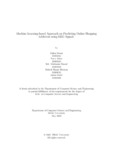| dc.contributor.advisor | Chakrabarty, Amitabha | |
| dc.contributor.advisor | Karim, Dewan Ziaul | |
| dc.contributor.author | Nawer, Nafisa | |
| dc.contributor.author | Jahan, Nazia | |
| dc.contributor.author | Fuwad, Md. Mubtasim | |
| dc.contributor.author | Bhuiyan, Mehedi Hasan | |
| dc.contributor.author | Kabir, Imtiaz | |
| dc.date.accessioned | 2023-10-15T10:19:51Z | |
| dc.date.available | 2023-10-15T10:19:51Z | |
| dc.date.copyright | ©2022 | |
| dc.date.issued | 2022-05-24 | |
| dc.identifier.other | ID 18201145 | |
| dc.identifier.other | ID 18301145 | |
| dc.identifier.other | ID 18301129 | |
| dc.identifier.other | ID 18301015 | |
| dc.identifier.other | ID 18201130 | |
| dc.identifier.uri | http://hdl.handle.net/10361/21822 | |
| dc.description | This thesis is submitted in partial fulfillment of the requirements for the degree of Bachelor of Science in Computer Science and Engineering, 2022. | en_US |
| dc.description | Cataloged from PDF version of thesis. | |
| dc.description | Includes bibliographical references (pages 29-33). | |
| dc.description.abstract | According to experts, shopping addiction is often a coping mechanism for those who are experiencing mental pain. As a result, to research online shopping addiction, researchers must look at changes in brain activity during emotional processing. For decades, electroencephalography (EEG) one among the most popular technologies for detecting psychological states by measuring various brain activity. Following this line of thought, we suggest a dual-track approach for predicting behavioral addiction in this research. We have at first collected EEG dataset and treat it by eliminating noise and encoding it. Furthermore, in order to achieve the highest degree of accuracy, we have proposed a six classification framework utilizing six distinct machine learning algorithms. The suggested model includes Multi-Layer Perceptron Classifier (MLP), Stochastic Gradient Descent (SGD), Support Vector Machine (SVM), Random Forest Classifier (RFC), Decision Tree (DTC) and Gated Recurrent Unit (GRU). The accuracy levels of those models have determined our ultimate conclusion and we have achieved the best performance based on accuracy of Multi-Layer Perceptron in our research that is 78% on Alpha bands, 82% on Beta bands and 85% on Gamma bands. In the end, we have suggested the severity of both Beta and Gamma bands in predicting Online Shopping Addiction precisely based on the cross-research analysis since the test accuracies of Beta (SVM-68%, MLP-82%, RFC-70%, SGD-61%, DT-59%, GRU-62.85%) and Gamma (SVM-81%, MLP-85%, RFC-77%, SGD-75%, DT-61%, GRU-76.91%) bands have been higher that that of Alpha bands (SVM-66%, MLP-78%, RFC-68%, SGD-61%, DT-57.99%, GRU-61.81%) in every classification model. | en_US |
| dc.description.statementofresponsibility | Nafisa Nawer | |
| dc.description.statementofresponsibility | Nazia Jahan | |
| dc.description.statementofresponsibility | Md. Mubtasim Fuwad | |
| dc.description.statementofresponsibility | Mehedi Hasan Bhuiyan | |
| dc.description.statementofresponsibility | Imtiaz Kabir | |
| dc.format.extent | 46 pages | |
| dc.language.iso | en | en_US |
| dc.publisher | Brac University | en_US |
| dc.rights | Brac University theses are protected by copyright. They may be viewed from this source for any purpose, but reproduction or distribution in any format is prohibited without written permission. | |
| dc.subject | Shopping addiction | en_US |
| dc.subject | Machine learning | en_US |
| dc.subject | Electroencephalography | en_US |
| dc.subject | Support | en_US |
| dc.subject | Vector machine | en_US |
| dc.subject | Gated recurrent unit | en_US |
| dc.subject | Decision tree | en_US |
| dc.subject | Random forest | en_US |
| dc.subject.lcsh | Brain mapping | |
| dc.subject.lcsh | Artificial intelligence--Engineering applications | |
| dc.title | Machine learning-based approach on predicting online shopping addiction using EEG signals | en_US |
| dc.type | Thesis | en_US |
| dc.contributor.department | Department of Computer Science and Engineering, BRAC University | |
| dc.description.degree | B.Sc. in Computer Science and Engineering | |

